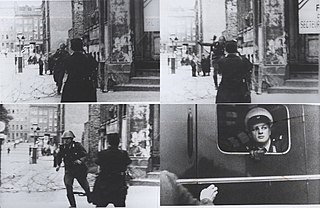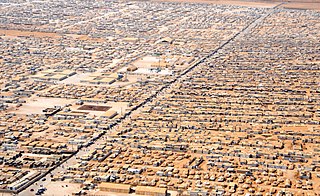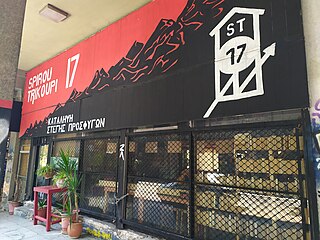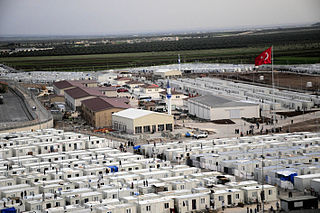Related Research Articles

The United Nations High Commissioner for Refugees (UNHCR) is a UN agency mandated to aid and protect refugees, forcibly displaced communities, and stateless people, and to assist in their voluntary repatriation, local integration or resettlement to a third country. It is headquartered in Geneva, Switzerland, with over 17,300 staff working in 135 countries.

A refugee, generally speaking, is a displaced person who has crossed national boundaries and who cannot or is unwilling to return home due to well-founded fear of persecution. Such a person may be called an asylum seeker until granted refugee status by the contracting state or the United Nations High Commissioner for Refugees (UNHCR) if they formally make a claim for asylum. The lead international agency coordinating refugee protection is the United Nations Office of the UNHCR. The United Nations has a second office for refugees, the United Nations Relief and Works Agency (UNRWA), which is solely responsible for supporting the large majority of Palestinian refugees.

A refugee camp is a temporary settlement built to receive refugees and people in refugee-like situations. Refugee camps usually accommodate displaced people who have fled their home country, but camps are also made for internally displaced people. Usually, refugees seek asylum after they have escaped war in their home countries, but some camps also house environmental and economic migrants. Camps with over a hundred thousand people are common, but as of 2012, the average-sized camp housed around 11,400. They are usually built and run by a government, the United Nations, international organizations, or non-governmental organization. Unofficial refugee camps, such as Idomeni in Greece or the Calais jungle in France, are where refugees are largely left without support of governments or international organizations.

Afghan refugees are citizens of Afghanistan who were compelled to abandon their country as a result of major wars, persecution, torture or genocide. The 1978 Saur Revolution followed by the 1979 Soviet invasion marked the first wave of internal displacement and international migration from Afghanistan to neighboring Iran and Pakistan; smaller numbers also went to India or to the former Soviet Union. Between 1979 and 1992, more than 20% of Afghanistan's population fled the country as refugees. When the Soviet forces left Afghanistan in 1989, many began returning to their homeland. They again migrated to neighboring countries during and after the Afghan Civil War (1992–1996) but between 2002 and 2022 most have returned to Afghanistan.

Refugees of Iraq are Iraqi nationals who have fled Iraq due to war or persecution. Throughout the past 30 years, there have been a growing number of refugees fleeing Iraq and settling throughout the world, peaking recently with the latest Iraq War. Precipitated by a series of conflicts including the Kurdish rebellions during the Iran–Iraq War, Iraq's Invasion of Kuwait (1990) and the Gulf War (1991), the subsequent sanctions against Iraq, and culminating in the violence during and after the American-led invasion and occupation of Iraq, millions have been forced by insecurity to flee their homes in Iraq. Like the majority of refugees worldwide, Iraqi refugees have established themselves in urban areas in other countries rather than in refugee camps. In April 2007, there was an estimate of over four million Iraqi refugees around the world, including 1.9 million in Iraq, 2 million in neighboring Middle East countries, and around 200,000 in countries outside the Middle East. The United Nations High Commissioner for Refugees (UNHCR) has led the humanitarian efforts for Iraqi refugees. The Iraqi displacement of several million was the largest in the Middle East at the time, and was even larger than the number of Palestinians who were displaced in 1948 during the creation of the state of Israel.

Syrian diaspora refers to Syrian people and their descendants who chose or were forced to emigrate from Syria and now reside in other countries as immigrants, or as refugees of the Syrian Civil War.

The Iraqi diaspora refers to native Iraqis who have left for other countries as emigrants or refugees, and is now one of the largest in modern times, being described by the UN as a "humanitarian crisis" caused by the 1991 Gulf War and 2003 invasion of Iraq and by the ensuing war.

Palestinians in Iraq are people of Palestinians, most of whom have been residing in Iraq after they were displaced in 1948. Before 2003, there were approximately 34,000 Palestinians thought to be living in Iraq, mainly concentrated in Baghdad. However, since the 2003 Iraq War, the figure lies between 10,000–13,000, although a precise figure has been hard to determine. The situation of Palestinians in Iraq deteriorated after the fall of Saddam Hussein and particularly following the bombing of the Al-Askari Mosque in 2006. Since then, with the rise in insecurity throughout Iraq, they have been the target of expulsion, persecution and violence by Shia militants, and the new Iraqi Government with militant groups targeting them for preferential treatment they received under the Ba'ath Party rule. Currently, several hundred Palestinians from Iraq are living in border camps, after being refused entry to neighbouring Jordan and Syria. Others have been resettled to third countries.
There have been many waves of refugees and emigrants from Iraq since the late 1970s until the present. Major events the modern history of Iraq resulted in the flight of what are now millions of Iraqis: more than three decades of repression and occasional violent attacks and massacres against the Kurdish population in the north and the Shi'a in the south perpetrated by Saddam Hussein's regime, the Iran–Iraq War of 1980–1988, the 1991 Gulf War, the economic sanctions that lasted from 1991 until the toppling of Saddam Hussein, and the 2003 US-led invasion of Iraq.
Al-Waleed is a makeshift Palestinian refugee camp in Iraq, near the border with Syria and the al-Tanf Crossing, and not far from the border with Jordan. It was set up in 2006 by Iraqi-Palestinian and Iraqi refugees stranded at the Iraqi–Syrian border. The United Nations High Commissioner for Refugees has two field staff stationed in the camp. In 2008, it had a population of 1,649 refugees, 1,602 of whom were Palestinians and the remainders Iraqis.
The 2004 Qamishli riots were an uprising by Syrian Kurds in the northeastern city of Qamishli in March 2004. The riots started during a chaotic football match, when some Arab fans of the guest team started raising pictures of Saddam Hussein, an action that angered the Kurdish fans of the host team, because of Hussein's Anfal campaign against Iraqi Kurds. Both groups began throwing stones at each other. The Ba'ath Party local office was burned down by Kurdish demonstrators, leading to the security forces reacting. The Syrian army responded quickly, deploying troops backed by tanks and helicopters, and launching a crack-down. Events climaxed when Kurds in Qamishli toppled a statue of Hafez al-Assad. At least 30 Kurds were killed as the security services re-asserted control over the city. As a result of the crackdown, thousands of Syrian Kurds fled to Iraqi Kurdistan.
Refugees of the Syrian Civil War are citizens and permanent residents of Syria who have fled the country over the course of the Syrian Civil War. The pre-war population of the Syrian Arab Republic was estimated at 22 million (2017), including permanent residents. Of that number, the United Nations (UN) identified 13.5 million (2016) as displaced persons, requiring humanitarian assistance. Of these, since the start of the Syrian Civil War in 2011 more than six million (2016) were internally displaced, and around five million (2016) had crossed into other countries, seeking asylum or placed in Syrian refugee camps worldwide. It is often described as one of the largest refugee crises in history.

Zaatari is a refugee camp in Jordan, located 10 kilometres (6.2 mi) east of Mafraq, which has gradually evolved into a permanent settlement; it is the world’s largest camp for Syrian refugees. It was first opened on 28 July 2012 to host Syrians fleeing the violence in the ongoing Syrian War that erupted in March 2011. It is connected to the road network by a short road which leads to Highway 10.

Syrian refugee camp and shelters are temporary settlements built to receive internally displaced people and refugees of the Syrian Civil War. Of the estimated 7 million persons displaced within Syria, only a small minority live in camps or collective shelters. Similarly, of the 8 million refugees, only about 10 percent live in refugee camps, with the vast majority living in both urban and rural areas of neighboring countries. Beside Syrians, they include Iraqis, Palestinians, Kurds, Yazidis, individuals from Somalia, and a minority of those who fled the Yemeni and Sudanese civil wars.
Refugees in Jordan rose with the uprising against the Syrian government and its President Bashar al-Assad. Close to 13,000 Syrians per day began pouring into Jordan to reside in its refugee camps.

The 2015 European migrant crisis, also known internationally as the Syrian refugee crisis, was a period of significantly increased movement of refugees and migrants into Europe in 2015, when 1.3 million people came to the continent to request asylum, the most in a single year since World War II. Those requesting asylum in Europe in 2015 were mostly Syrians, but also included significant numbers of Afghans, Nigerians, Pakistanis, Iraqis and Eritreans, as well as economic migrants from the Balkans.

Migrants have gathered in and around Calais, on the northern French coast, since at least the late 1990s seeking to enter the United Kingdom from the French port by crossing the Channel Tunnel or stowing away in the cargo area of lorries heading for ferries that cross the English Channel. During this time, informal camps of migrants have formed, the most notorious commonly referred to as the Calais Jungle. Other migrants come to the area because they are homeless while seeking asylum in France. The presence of migrants in and around Calais has affected the British and French governments, the Eurotunnel and P&O Ferries companies, and lorry drivers heading for the UK and their companies. EuroTunnel, the company that operates the Channel Tunnel, said that it intercepted more than 37,000 migrants between January and July 2015.
A Refugee crisis can refer to difficulties and dangerous situations in the reception of large groups of forcibly displaced persons. These could be either internally displaced, refugees, asylum seekers or any other huge groups of migrants.

Athens refugee squats exist since the 2015 spike in the European migrant crisis, Greece has been a destination for migrants seeking refuge on the European continent via the "Balkan Route." Coalitions of solidarity groups and migrants have established squats throughout Athens to house refugees, demonstrating an alternative to solutions offered by the European Union and NGOs. The squats are grouped together in the Coordination of Refugee Squats. Notable projects included 5th School and City Plaza. In late 2019, the New Democracy party declared it would evict all the squats.

Turkey's migrant crisis, sometimes referred to as Turkey's refugee crisis was a period during the 2010s characterized by high numbers of people arriving in Turkey. Turkey received the highest number of registered refugees of any country or territory every year from 2014 to 2019, and had the world's largest refugee population according to the United Nations High Commissioner for Refugees (UNHCR). The majority are refugees of the Syrian Civil War, numbering 3,591,892 as of June 2020. In 2018 the UNHCR reported that Turkey hosted 63.4% of all the "registered Syrian refugees."
References
- 1 2 "Site profile:Diavata" (PDF). UNHCR. 12 May 2016. Archived from the original (PDF) on 13 August 2016.
- ↑ "Sites in Greece". UNHCR. 1 July 2016.
- 1 2 "Site profile:Diavata" (PDF). UNHCR. 14 June 2016.
- ↑ "Strong presence of police at Diavata due to reactions for refugee reception centre". Themanews. 13 February 2016.
- ↑ "Greece: Protesters decry refugee hotspot near Thessaloniki". news.com.au. 17 February 2016. Archived from the original on 19 August 2016. Retrieved 3 July 2016.
- ↑ "Live Ticker: 21.04.2016". Moving Europe. 21 April 2016.
- ↑ "Fire at Diavata refugee centre extinguished, no injuries". Phantis. 21 April 2016. Archived from the original on 23 June 2016. Retrieved 3 July 2016.
- ↑ "Live Ticker: 05.04.2016". Moving Europe. 7 April 2016.
- ↑ "Site profile:Diavata" (PDF). UNHCR. 14 April 2016.
40°42′08″N22°51′50″E / 40.7022°N 22.8639°E Coordinates: 40°42′08″N22°51′50″E / 40.7022°N 22.8639°E